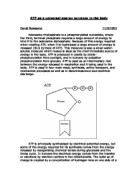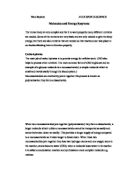()
Types of energy:
- Chemical
- Radiant
- Sound
- Nuclear
- Electro-magnet
The role of energy
Our body requires energy for all functions, movement, reproduction and respiration. Energy assists us in everyday life by helping us to exercise, cook and clean.
How we get/ make the energy metabolism
The human body consumes energy through food. The food is measured in units either kilojoules or calories. Energy is used in the body in three different ways:
- Basal metabolism- energy required to keep the body functioning at a reasonable level.
- Physical activity
- Thermogenesis- assimilation of food.
Supplying energy to the cells
The digestive system is responsible for taking food and water, using enzymes and breaking up complex molecules into simple soluble pieces which can pass into the adjacent capillaries of the cardiovascular system. The cardiovascular transports the simplified pieces into the liver and body cells through the bloodstream. This happens by the pump in the heart. The respiratory system also refreshes the lungs constantly of oxygen and removes the waste such as carbon-dioxide and water while breathing. The dissolved oxygen will pass through the thin alveolar walls into the bloodstream and is then transported to cells. Body cells constantly deliver materials like glucose and nutrients. The breakdown process of glucose take place and energy is released. This will start to take place in the cytoplasm and then complete its self in the mitochondria.
Energy metabolism
Metabolism is the sum up of all the chemical reactions which take place in the human body. This will involve using and releasing energy from chemical substances.
The respiratory system
The respiratory system brings oxygen into the body through blood cells. The oxygen then converts to the cells and contributes to the production of ATP which is necessary for energy metabolism Air passes through the conducting airway until it reaches the alveoli. The walls of the alveoli are only one cell thick and this is called the respiratory surface, which is about 70 square metres, where the exchange of gases takes place. Around the alveoli there are microscopic capillaries that bring carbon dioxide from the heart artery and delivers oxygen back to the heart through the pump vein. Gas exchange happens when there is a difference in partial pressure at the semi-permeable membrane of the alveoli. The diffusion occurs when the higher concentration of a gas moves to the lower concentration until equilibrium is achieved. The respiratory system enables the production of energy by supplying cells with a continuous supply of oxygen. The system is also responsible for the elimination of carbon-dioxide. The cell respiration is when the energy in organic molecules is released as glucose. The anatomical structure of the respiratory system provides the mechanism for transporting oxygen.
Contents of air
Inhaled air contains:
- more oxygen used to create energy
- Less carbon dioxide than
Exhaled air which contains:
- more carbon dioxide produced as a waste product of energy production
- less oxygen as it has been used in respiration
Gas exchange takes place by diffusion in the alveoli within the lungs. As a result the composition of inhaled and exhaled air is different.
Stages
- Air is warmed, moistened and filtered as it travels through the mouth and nasal passages.
-
It then passes through the trachea and one of the two bronchi into one of the lungs.
- After passing into the many bronchioles, it finally arrives into some of the millions of tiny sacs called alveoli.
- This is where gas exchange takes place - oxygen passes out of the air into the blood, and carbon dioxide passes out of the blood into the air in the alveoli.
Alveoli
The surface of alveoli is thin and moist. It is like this so that gases can pass through or be exchanged easily. Surface size means how large the surface of the alveoli is. Alveoli are smaller than grains of salt and there are 300 million of them in the lungs. Alveoli have a very large surface area in total; plenty of room for gas exchange. The surfaces of the alveoli are covered with capillaries. These are narrow blood vessels which are one cell thick. Oxygen is passed from the alveoli into the bloodstream, which then distributes it to cells where it is used to unlock energy from food. The blood carries carbon dioxide, a waste product from the oxygen combusting with food in cells, back to the capillaries, where it goes back through the walls of the alveoli and is breathed out when you exhale, as waste. Blood flows into the lungs from around the body. It carries carbon dioxide produced by respiration in the cells of the body. Carbon dioxide passes from the blood into the alveoli. Then it is breathed out of the body. Oxygen is breathed into the lungs. It dissolves in the water lining of the alveoli. From there, it passes into the blood. Blood carries oxygen away from the lungs to every cell in the body where it is used for respiration.
Image from: ()
The Digestive system
The digestive system is related to energy metabolism glucose is used fuel for the production of ATP. Glucose comes from the digestion of carbohydrate. The glucose is then absorbed into the capillaries of the small intestine and then transported by the portal circulation to the liver. The glucose then becomes an oxidant in the liver which provides chemical energy in the form of ATP. The oxidation of carbohydrates and fat provide most of the energy that the body requires. If the glycogen stores become low the body can use glucose from non-carbohydrates in the body for example amino acids. Actively the glucose will be transported into the cells of the small intestine and across the capillaries walls. It is necessary that the transport is completes diffusion would be too slow to keep up with the bodies needs. The glucose is broken down into the body to give carbon-dioxide, energy and water. The catabolism of glucose occurs when the large molecules are broken down into smaller pieces which cause them to release a chemical energy which is stored as ATP.
There is a large amount of organs in the digestive system. The process of the digestive system combines with the function of breaking down food into smaller molecules; this can then be used to produce energy. Digestion occurs in a series of tubes (the oesophagus and intestines).
Mouth- the mouth is the first stage of the digestion cycle. The process of chewing starts to break down the food. Enzymes like saliva lipase and amylase also start to chemically break down food.
Oesophagus- once the food is swallowed the food moves into the oesophagus where continuous waves of contraction push the food into the stomach.
Stomach- the stomach has both a mechanical and chemical function. The upper part of the smooth stomach muscle relaxes to allow large amounts of food to be stored. The lower muscle then acts as a rhythmical manner in order to churn the food (like a cement mixer) and mix it together with gastric acids and digestive enzymes. T5he amylase, lipase, gastric and gelatinase break the food down further. The stomach then empties the contents into the small intestine.
Small intestine- the food is then subjected to more enzymes, the pancreas and the glands break down carbohydrates and proteins within the intestine walls. It is also mixed with a product of the liver which is stored and released into the intestine by the gallbladder. This is known as bile. The bile will dissolve fat so that it can be digested by other enzymes. The food is then pushed through a narrow tube by the smooth muscle contraction. Once the food is completely broken down into individual components it is absorbed through the intestine walls. To make the process faster and more efficient the intestine walls contain numerous folds which cover in a finger like protection called the villi. The increase the surface area of the intestine wall for molecules of digested food to pass through.
Large intestine- the large intestine continues the food journey and is the last chance for the body to absorb any water or minerals still remaining. The other contents of the large intestine are waste such as undigestable pieces of food and fibre. This is passed through to the rectum and stored until you use the bathroom.
The cardiovascular system
The cardiovascular system has to provide oxygenated blood to the body at a rate sufficient to meet energy requirements. The main limiting factor is oxygen delivery which is closely followed by CO2 removal. The metabolic rate is very closely related to oxygen consumption they are almost proportional, changing only with the respiratory quotient (which is in turn based on the type of fuel being used; e.g. carbohydrate, fat, protein). To a very reasonable approximation, oxygen consumption is proportional to metabolic rate. But in equilibrium, oxygen consumption must equal oxygen delivery by the cardiovascular system. As oxygen is usually carried at the same concentration in blood (close to 100% saturated), this means that the cardiac output is proportional to the oxygen delivered to the tissue per unit time, and hence to the metabolic rate. This cardiac output is mainly controlled by changes in heart rate and contractility, which are controlled by hormones and the autonomic nervous system. For example adrenaline and thyroid hormone. So the rate of energy production in body is proportional to cardiac output, the main function of the cardiovascular system. The heart comprises of two separate circuits and blood passes through the heart twice.
The ventricle circuit carries blood to the lungs to be oxygenated and then back to the heart. In the lungs, carbon dioxide is removed from the blood, and oxygen taken up by the haemoglobin in the red blood cells.
The atrium circuit carries blood around the body to deliver the oxygen and returns de-oxygenated blood to the heart. The right side of the heart pumps de-oxygenated blood (blood not containing oxygen) to the lungs to pick up oxygen. The left side of the heart pumps the oxygenated blood from the lungs around the rest of the body.
Blood also carries nutrients and waste. The two atria collect the blood. The two ventricles pump the blood out of the heart. The Valves will prevent the blood from flowing backwards. The septum separates the two sides of the heart.
The heart has four chambers
Arteries
- Carry blood away from the heart (always oxygenated apart from the pulmonary artery which goes to the lungs)
- Have thick muscular walls
-
Have small passageways for blood (internal lumen)
- Contain blood under high pressure
Veins
- Carry blood to the heart (always de-oxygenated apart from the pulmonary vein which goes from the lungs to the heart)
- Have thin walls
-
Have larger internal lumen
- Contain blood under low pressure
- Have valves to prevent blood flowing backwards
Capillaries
- Found in the muscles and lungs
- Microscopic – one cell thick
- Very low blood pressure
-
Where gas exchange takes place. Oxygen passes through the capillary wall and into the tissues, carbon dioxide passes from the tissues into the blood
Blood has four key components:
Plasma
- Fluid part of blood
- Carries carbon dioxide, hormones and waste
Red blood cells
- Contain haemoglobin which carries oxygen
- Made in the bone marrow. The more you train the more red blood cells are made.
White blood cells
- Protect the body by fighting disease
- Made in the long bones
Platelets
- Clump together to form clots
- Protect the body by stopping bleeding
Images from:








